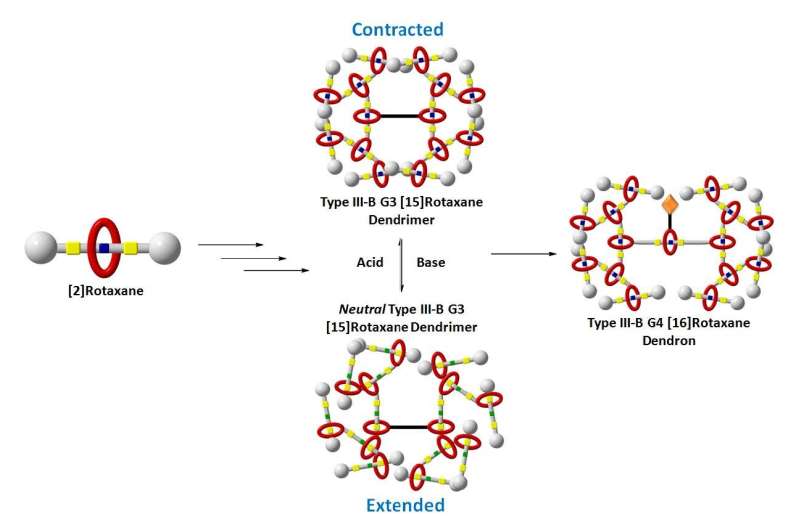Breakthrough in macromolecular machines for actively controlled cancer drug delivery

Hong Kong Baptist University (HKBU) scholars demonstrated the design and synthesis of a smart globular macromolecular machine vehicle for actively controlled cancer drug delivery that enhances the drug's efficacy. This breakthrough gives insight to targeted therapy drugs such as Chlorambucil in the treatment of leukemia. The paper, titled "Higher-Generation Type III-B Rotaxane Dendrimers with Controlling Particle Size in Three-Dimensional Molecular Switching," was published in Nature Communications.
The team reported on a series of novel hyperbranched macromolecules with, at most, 15 mechanical bonds at the branching unit. Mechanical bonds are a novel and exciting class of non-covalent bonds similar to familiar chains and hooks, for example. These macromolecules can induce an overall extension-contraction molecular motion via collective and controllable molecular back-and-forth shuttling, providing the ability to encapsulate drug molecules and release them actively by acidic stimuli.
Dr Ken Leung, who led the research, said that in current leukemia treatment, drugs are delivered to kill leukemia cells that may be present in the blood and bone marrow. The amount of drugs released to kill the free-floating cancer cells cannot be effectively controlled, however. He said the 15 mechanical bonds resemble mechanical arms that actively control the delivery and suitable amount of drugs released to targeted cancer cells.
Dr Leung added that this smart material combines molecular machines and dendrimers with a new breakthrough in synthesis as well as controlled and active drug release. With its complexity and size, this synthetic molecule resembles a small virus. Due to the relatively low toxicity of this smart globular molecular vehicle, it can also serve as a potentially ideal long-term drug delivery molecular machine within the human body. The molecular masses of these new macromolecules were characterised by mass spectrometry, and their chemical structures and physical properties were also verified with supercomputer simulations.
Kwan Chak-shing, who completed the synthesis of the macromolecules, said, "The syntheses of macromolecular machines is complicated, whereas the intermediate compounds require the formation of mechanical bonds followed by careful purification and characterisation. I look forward to seeing more creative research work done in HKBU."
Molecular machines are assembled with molecular counterparts that are responsive to specific stimuli (input) and produce mechanical movements (output). Rotaxane dendrimers are molecular interlocked molecules that combine hyperbranched macromolecules with molecular machines. Among various types of rotaxane dendrimer, type III-B possesses the most complicated molecular structure and exhibits the largest extension-contraction properties. The breakthrough in the synthesis and the control of particle size of higher-generation rotaxane dendrimers could give scientists insight to develop more sophisticated molecular machines for functional materials and nanotechnology, such as the delivery of drugs or biomolecules.
More information: Chak-Shing Kwan et al, Higher-generation type III-B rotaxane dendrimers with controlling particle size in three-dimensional molecular switching, Nature Communications (2018). DOI: 10.1038/s41467-018-02902-z
Journal information: Nature Communications
Provided by Hong Kong Baptist University


















